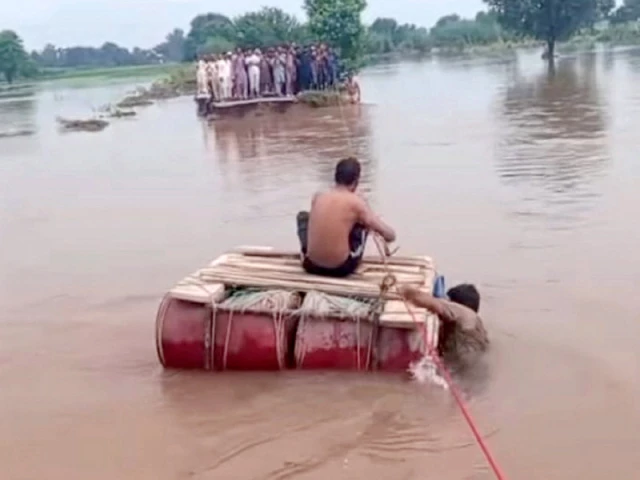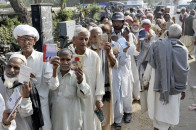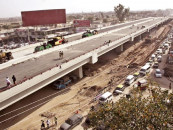Fresh alerts as Sutlej, Chenab swell further
India's water release triggers high flood risk in Punjab rivers

Authorities in Pakistan issued fresh flood alerts on Monday after India released a large volume of water into the Sutlej and Chenab rivers without prior notice, raising the threat of severe inundation across multiple districts of Punjab.
Officials said India bypassed the communication channels laid down in the Indus Waters Treaty (IWT) and informed Islamabad only after the release, through the Indian High Commission.
Pakistan's Ministry of Water Resources confirmed high flood levels at Lower Harike and Lower Ferozepur on the Sutlej, with water flows surging since early September 1.
Punjab's Provincial Disaster Management Authority (PDMA) warned that floodwaters from the Sutlej could affect nine districts: Kasur, Okara, Pakpattan, Bahawalnagar, Vehari, Lodhran, Bahawalpur, Multan and Muzaffargarh. Deputy commissioners in the areas were directed to make immediate preparations.
The Sutlej River is experiencing an extraordinary flow of 253,068 cusecs. Additional rainfall in the upper catchments and water releases from dams may generate another flood wave of up to 300,000 cusecs.
At Jassar, the Ravi River is currently flowing normally with 60,094 cusecs. However, due to possible rainfall and water releases from Thein Dam, the flow at Jassar may rise to 150,000 cusecs. Owing to possible rainfall, flash flooding is feared in the Ravi's tributariesBein, Bansanter, and Dek.
The Ravi River also rose to dangerous levels near Renala Khurd, where dozens of villages were cut off. In Khanewal district, floodwaters from the Ravi and Chenab rivers submerged thousands of acres of crops, forcing mass evacuations.
At Burewala, a wave of 190,000 cusecs continued to sweep through farmland, destroying cotton, rice, maize and sesame plantations. Several protective embankments collapsed, allowing waters to spread as far as Sahuja. The spillway of Simly Dam was also opened after the water level reached 2,314.90 feet.
At Marala, the Chenab River is currently at a low level with a flow of 94,728 cusecs. Rains in Jammu and Indian Illegally Occupied Jammu & Kashmir (IIOJK), coupled with water releases from upstream dams including Salal, Baglihar, and Dul Hasti, are likely to cause a sharp rise in flow.
PDMA Director General Irfan Ali Kathia said India had released water from Salal, Nangal and Harike barrages, sending a large wave downstream that could hit Head Marala within two days.
In Jhang, the Trimmu Headworks recorded flows of more than 550,000 cusecs, submerging dozens of villages and cutting road links. Floodwaters inundated major routes including Sargodha Road and Pirkot Masan Road, prompting highway officials to deploy heavy machinery.
Punjab officials said more than 500 roads and 60 bridges had been damaged across the province.
Provincial Information Minister Azma Bukhari described the situation as "extraordinary," blaming India's sudden water release for compounding monsoon flooding already underway. She said rescue teams using drones and thermal imaging had evacuated thousands and that relief operations were ongoing.
Residents in Narowal reported entire roads washed away, isolating communities. In one case, a family returning from a funeral in Lahore was stranded after the only access road to their village was swept off by floodwaters. Farmers in several districts said fodder shortages had left their livestock at risk.
Authorities in Punjab and Sindh pledged continued relief and rehabilitation for displaced families. Bukhari urged political parties to set aside disputes and focus on joint planning for riverbed settlements and flood defenses, saying, "This is not the time for politics."
The Pakistan Meteorological Department (PMD) forecast more heavy rains through September 3 across Punjab, Khyber Pakhtunkhwa (K-P) and Kashmir, warning of further flash floods, landslides and road closures in vulnerable areas. The PMD issued a red warning for heavy rains from September 1 to 3.
It cautioned that torrential downpours could trigger urban flooding in low-lying neighborhoods and flash floods in local streams across Islamabad, Rawalpindi, Narowal, Sialkot, Gujranwala, Gujrat, Mandi Bahauddin, Lahore, Kasur, Okara, Sheikhupura, Hafizabad and nearby districts.
Similar conditions are expected in Jammu, Bhimber, Mirpur, Kotli, Punch, Haveli and adjoining areas, where intense showers may also set off landslides and urban flooding.
Vulnerable hilly terrain in the K-P, Murree, Galliyat and Kashmir faces the risk of landslides and mudslides that could lead to road closures, prompting officials to advise residents, travelers and tourists to stay away from hazardous locations and remain updated on weather alerts.
Meteorologists said the system is being fueled by monsoon currents moving in from the Bay of Bengal and the Arabian Sea, along with a westerly disturbance affecting the country's upper regions, which is expected to persist through Tuesday.
They predicted widespread rain, wind and thunderstorms in Kashmir and northeast Punjab, with scattered activity in Islamabad and upper K-P. Heavy rainfall is likely in parts of Kashmir, northeast Punjab, Islamabad and upper K-P, while hot and dry weather is set to prevail elsewhere.
During the past 24 hours, scattered rain and thunderstorms lashed upper K-P, Kashmir, northeast Punjab, Islamabad and Gilgit-Baltistan, while the rest of the country remained hot and humid. Saidu Sharif recorded 26mm of rain, Balakot 25, Malam Jabba 16, Garhi Dupatta 24, Kotli 8 and Kasur 9.
In Islamabad, Saidpur logged 10mm, and Golra 4, while Narowal reported 5 and Rawalpindi Chaklala 3, Chilas in Gilgit-Baltistan received 8mm. Despite the widespread showers, parts of Balochistan stayed scorching, with Dalbandin recording the highest temperature at 43 Celsius, followed by 42 in Nokundi.
Punjab is already facing one of the worst flood pressures in its history.
PDMA Director General Irfan Ali Kathia said so far, more than 3,100 villages and 2,900 settlements have been inundated, affecting over 2.4 million people. At least 41 people have lost their lives, with eight injured, while thousands of homes and vast stretches of farmland have been destroyed.
Rescue agencies are carrying out the largest operation in their history, having evacuated over 900,000 people to safe locations, along with more than 600,000 livestock. The Livestock Department is providing fodder and feed to the displaced animals.
However, the ninth spell of the monsoon is expected to bring more rainfall in the next 48 hours, which could worsen conditions in Rawalpindi's Nullah Leh and other low-lying areas.
Meanwhile, rising floodwaters of the Sutlej River have reached the Ganda Singh border in Kasur, forcing the suspension of the traditional evening flag-lowering ceremony jointly held by Pakistan Rangers Punjab and India's Border Security Force (BSF).
According to officials, the suspension will remain in place until the floodwaters fully recede.
They confirmed that water entering from Kasur has inundated parts of the border region, while on the Indian side, low-lying areas of Ferozepur district are also being affected. Authorities on both sides have agreed to suspend the daily parade for safety reasons until the situation normalizes.
The National Disaster Management Authority (NDMA) projected that a peak flow of 1.3 million cusecs could reach Sindh by September 5. Sindh Chief Minister Murad Ali Shah said his government is fully prepared to deal with a super flood, with arrangements in place to safely manage a flow of up to 900,000 cusecs.
He warned, however, that 1.2 to 1.3 million cusecs of water from India could reach Guddu Barrage. Shah noted that 550,000 cusecs had already safely passed through Sukkur and Kotri barrages, adding that the barrages have the capacity to withstand flows of up to one million cusecs.
WITH INPUT FROM OUR CORRESPONDENT IN KARACHI



















COMMENTS
Comments are moderated and generally will be posted if they are on-topic and not abusive.
For more information, please see our Comments FAQ